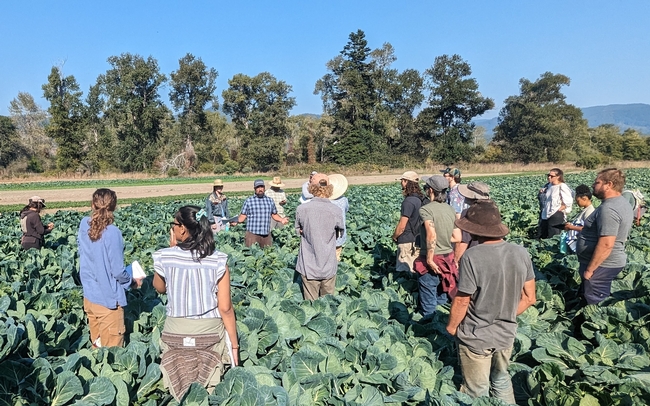Posts Tagged: survey
Report outlines top concerns in California organic agriculture
Organic Agriculture Institute needs assessment refines how it can address pressing challenges
The explosive growth of organic agriculture in the U.S. – reflected in a 90% increase in organic farms from 2011 to 2021, according to U.S. Department of Agriculture statistics – has come at a cost for some farmers. With new farming operations increasing the supply of organic commodities, along with consolidation of buyers, growers report that their profit margins are not what they used to be.
Those market size considerations are among the challenges highlighted in a new report detailing the initial findings by the University of California Organic Agriculture Institute on the most pressing needs of the state's organic sector. OAI gathered and analyzed data from 423 responses to an online grower survey, over 60 interviews with stakeholders across the organic community, and additional observations from farm visits and workshops.
The report describes other frequently mentioned systemic priorities, such as maintaining integrity of the term “organic,” developing a market for organic seeds, spreading consumer awareness, and alleviating the burdens of organic certification and reporting.
Shriya Rangarajan, the postdoctoral researcher with OAI leading this statewide needs assessment, said that the reported challenges varied by organic status (fully certified, transitioning to organic, or a mixed farm with some conventional), type of crop, as well as size of the operation. She noted survey respondents were roughly representative of the sector overall – 70% small-scale growers and 30% medium and large.
“Organic is not a homogenous industry, to say the least – small growers and large growers are very different; for small growers, their challenges tend to be financial and regulatory, especially relating to certification requirements and labor,” said Rangarajan. She added that larger growers mentioned different types of challenges, weeds and pest pressures for instance, given the difficulty in controlling managing these at scale without the use or availability of organic inputs.
Organic Agriculture Institute key to sharing resources across state
Another common theme from the assessment is that the organic sector needs more accessible resources to address those myriad concerns. For OAI, established in 2020 under UC Agriculture and Natural Resources, the initial findings validated and refined the direction of its research and extension programs.
“As a new organization, we've been trying to figure out where we fit into this ecosystem and how we can support it,” said Houston Wilson, a UC Cooperative Extension entomology specialist who has served as OAI's director since its founding.
Because OAI was envisioned as a hub of resources and connections for California's organic community, Wilson and his colleagues are especially interested in understanding how its constituent members obtain information – and how OAI can improve their access.
“Growers are finding it difficult to navigate the resources that exist for organic agriculture, like technical information, financial support, compliance and certification support,” Wilson said. "While we'd like to see more resources for organic in general, those that currently exist can sometimes be hard to navigate or it can be hard to know where to go for the right thing – that became really apparent early on.”
While some producers are contacting OAI directly with their questions, Wilson is eager to develop tools and systems that can serve the community more broadly. For example, Wilson and Krista Marshall – OAI's policy and partnerships coordinator – are currently beta-testing a new map tool, built in conjunction with UC ANR's Informatics and GIS (IGIS) team. The map, expected to be ready in fall 2024, will enable users to click on their county and see all available resources related to organic agriculture.
Wilson added that OAI will have four full-time staffers by fall, further expanding its research, extension, and education efforts. After holding four field events this past year, OAI aims to increase activities in the coming year, including not just field events but also online resources, webinars and more. Also, a new training and technical assistance coordinator will be tasked with bringing Cooperative Extension advisors and other technical assistance personnel across the state up to speed on a range of organic topics, so they can more effectively answer questions from clientele in their region.
New survey aims to trace crucial organic knowledge networks
Although the OAI team has gained a sense of how information is shared across the organic community (and started to formalize those interconnections through a California Organic Agriculture Knowledge Network), they are now developing a survey to study those relationships more systematically.
“We're trying to understand what kind of knowledge resources people tap into, which is something that has come up repeatedly in our needs assessment,” Rangarajan said. “We're trying to understand who people are speaking to because, at the end of the day, organic is still a relatively small part of agriculture in California, and that makes it more fragmented. So trying to connect those different parts becomes important.”
Once Wilson has a more nuanced understanding of organic knowledge networks, he will be able to strategize and position OAI – and the UC – as a more effective partner and contributor in the sector.
“Given the history of organic, growers have had to rely on each other a lot,” Wilson explained. “We understand that the university has unique expertise to bring to the table, but we also acknowledge that there's all these other knowledge holders out there, so one of the roles that we see ourselves having is helping to facilitate those connections, strengthen them and increase the frequency of interaction.”
That may include further supporting efforts that connect transitioning organic farmers with experienced growers (a mentorship program led by Certified California Organic Farmers, or CCOF), or giving more structure to grower-researcher partnerships that can help address a host of production challenges. In OAI's grower survey, weed management topped the list, followed by water and disease issues, all exacerbated by climate variability.
“I think a lot of the real innovation changes are coming through growers experimenting with their own practice,” Rangarajan explained. “From a research perspective, one of the best ways to take this forward would be to formalize those experiments in some way so that knowledge becomes more reportable.”
And collaboration on “organic topics,” such as finding alternatives to synthetic pesticides, are a boon to the entire agricultural sector – conventional growers included.
“Everyone is trying to reduce pesticide use; everyone is trying to reduce environmental impacts,” Wilson said. “You don't have to be certified organic to benefit from organic research; these practices can be used by anyone.”
The report with OAI's initial findings on organic needs can be found at: https://ucanr.edu/sites/organic/files/396228.pdf.
Employees of UC ANR, we heard you
Through your comments on the three ANR@Work surveys, at the 2023 Statewide Conference, in our Town Halls, in the development of our Strategic Plan, in outreach sessions and other engagements, you shared your ideas, needs and experiences about working at UC ANR. Your feedback was and continues to be informative and powerful. It fuels our commitment to better UC ANR's work environment while we grow, adapt and deepen our impact on California's challenges and opportunities.
On Tuesday, Sept. 26, the fourth ANR@Work survey will be emailed to you. Please, take the time to respond to its questions. As the summary below shows, your voice is valued and critical to the ongoing success of our mission.
What follows is a snapshot, with links if you wish to learn more, of what has been done since the pandemic in three core internal areas: employee and organizational wellness, learning and development, and staffing and retention strategies.
Employee and Organizational Wellness
Employee comments emphasized the need for more knowledge about navigating within the UC ANR community. An urgency to address diversity and equity in the organization's programs and environment was also clear.
o Our first Director of Workplace Inclusion and Belonging was hired. Elizabeth Moon is responsible for developing and implementing diversity, equity and inclusion initiatives, and programs for our community.
o An agreement with the UC Davis Ombuds Serviceswas established to strengthen employee resources for conflict management and problem solving.
o A partnership with the UC Davis Harassment and Discrimination Assistance and Prevention Programwas established to ensure objectivity.
o Delayed by pandemic restrictions, the first ANR Statewide Conference in five years was held with over 800 attendees, the highest attendance ever.
o Two new employee resource groups (ERGs) were established. The Latinx & Friends Affinity Group, UC ANR Black and Allied Employees, People of Color ERG, and the LGBTQ+ ERG all foster communication, support and opportunities for employees with shared interests or affiliations. Contact Bethanie Brown if you are interested in starting a new ERG.
o The UC ANR Staff Assembly, of which all staff employees are members, strengthened its education and wellness reimbursements, established an Employee Experience and Engagement Challenge, and expanded its communications through a new e-newsletter, The Current.
o To enhance customer service, all administrative service units took part in related trainings, surveyed customers to learn their needs, and are now creating action plans in response.
Learning and Development
UC ANR is a complex organization, and employees expressed the need to better understand it from the get-go. More seasoned employees look for professional development opportunities to improve specific skills and shape themselves for career advancement.
o We continue to invest in learning and development, which increased 35% in FY22-23 and will double in FY23-24. Additional trainings and professional development presentations were archived to serve as a resource available at any time.
o For new employees, more regular administrative and programmatic orientations were established, supported by less formal monthly virtual informational meetings and a New ANR Employee Guide.
o A nine-month mentorship program was established to enable staff mentees to better understand UC ANR, establish contacts and design their career paths, and for academic mentees to help with program planning, research collaboration, outreach and the merit and promotion process.
o Daniel Obrist was hired as academic vice provost of academic personnel and development to oversee the recruitment, development, mentoring and evaluation of UC ANR academics.
o As part of all UC ANR operations, less-formal opportunities are available to employees, such as serving on committees, employee groups and recruitment panels, and, in coordination with their supervisor, evaluating and improving current responsibilities.
Staff Planning and Retention
Salary competitiveness and equity continues to be very high priority for employees. The constriction and post-pandemic workforce instability impacted the staffing of units across the organization.
o Successful recruitment for vacant staff and academic positions increased 25% over last fiscal year, although much work remains to fill vacancies.
o A centrally funded process for recruitment advertising was created to accelerate recruitments.
o Internal promotions of current employees increased 20% over last year, and reclassifications of current employees were up 35% over last year.
o To recruit and retain quality employees in areas where current pay levels are below competitive levels and to provide a more transparent pay philosophy, a multi-year equity program was implemented for non-represented employees. An academic equity adjustment program is currently under review.
o All non-represented staff and academics received a general pay increase.
o All UC ANR collective bargaining agreements for represented staff are in place, with covered employees receiving guaranteed pay increases for the duration of their agreement.
o Guidance for managing visas and work eligibility of international employees was created.
o Several statewide programs and administrative units have undergone an organizational review and developed customized staffing plans, including career-ladder opportunities for current employees.
o UC ANR increased funding for the annual Staff Appreciation and Recognition awards.
Bethanie Brown
Interim Executive Director of Human Resources
Your Voice Matters, Let Us Hear it! (Survey Digest)
Growers are said to be one of the most surveyed groups in the US. This is understandable as only around 2% of Americans work in agriculture and there is an intrinsic lack of understanding of what is needed to help growers develop their operations. I...
Seen Any Dead Butterflies? USGS Survey Seeks Specimens in Six States
Have you seen any dead butterflies lately? If you live in Alabama, Georgia, Kansas, Nebraska, Oklahoma or Texas, the United States Geological Survey (USGS) wants you to collect dead butterflies and moths and mail the specimens to...

A monarch butterfly, Danaus plexippus, nectaring on a Mexican sunflower, Tithonia rotundifola, in Vacaville, Calif. (Photo by Kathy Keatley Garvey)

A buckeye butterfly, Junonia coenia, on a Mexican sunflower, Tithonia rotundifola. (Photo by Kathy Keatley Garvey)
ANR Customer Satisfaction Survey deadline extended to June 23
Dear Colleagues,
Good news! We are extending the ANR Administrative and Support Services Customer Satisfaction Survey deadline from June 16 to June 23, 2023, to allow one more week for employees to share their feedback to this high-priority customer service initiative.
The 18 ANR Administrative and Support Services Units included in the survey provide a broad range of services — from human resources to business operations to communications to safety services to technology support.
If you have used services from one or several of these areas, we want to hear from you! You only need to rate the services that you have used in the last 12 months, or you can rate all services if you have used all.
The 2023 survey will help us determine areas that are working well and which areas need improvement. Your feedback is vital to this effort so that we may compare results from the 2021 survey to this 2023 survey in order to evaluate our progress and develop action plans for the next phase of our customer service enhancements.
We hope to receive 150 more survey responses during this last week to make the survey statistically more reliable. The more perspectives we receive, the more robust the data to inform and prioritize changes. As a token of appreciation for those who complete the survey during this extra week, we will conduct another random drawing and award 20 additional $20 Amazon gift cards.
Please complete your survey by June 23, 2023.
To take the survey, please refer to your May 23 email invitation from “UC ANR Administrative and Support Services Customer Satisfaction Survey <ANRcustomersatsurvey@ucanr.edu>.” This email included a unique survey link and access code for each employee. As a reminder, your survey responses are confidential.
If you have any questions, please send an email to ANRcustomersatsurvey@ucanr.edu. For additional information about the Customer Satisfaction Survey project, please visit the ANR Customer Service webpage: http://ucanr.edu/anrcustomersatsurvey.
Thank you in advance. We truly appreciate your feedback.
Tu Tran
Associate Vice President - Business Operations

